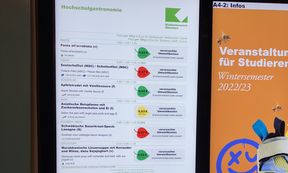New research: Labeling carbon footprint affects the choices of mass catering customers – and the labeling method matters, too!

A carbon footprint label prompts student canteen diners to choose lower-emission meal – this is revealed by a study conducted by the Aalto University School of Business and two German universities. The researchers recorded nearly 23,000 meals in a student canteen in Munich: based on the results, canteen customers chose significantly more environmentally friendly meals when presented with the carbon footprint of different meal options at food selection point.
The carbon footprint refers to the climate impact caused by a product or service, i.e., how much greenhouse gas is emitted throughout its life cycle. Interestingly, the information about CO2 emissions reduced the carbon footprint of meals even though the diners, most of whom were students, stated in a post-experimental survey accompanying the study that things like taste and appearance were much more important selection criteria than environmental concerns.
During their ten-day field experiment, the researchers tested different presentation formats of carbon footprint labels against each other and found that not only providing customers with any information on CO2 emissions at all, but also how to present the information matters. The most effective label was a three-level traffic-light color scheme combined with information about the price of the carbon footprint in euros.

'When we labeled the estimated emissions of meals for the serving line using a combination of red, yellow or green leaves and the price in euros, students chose meals with more than nine percent lower CO2 emissions than without the labels. The emissions were mainly reduced through a lower consumption of meat and fish dishes,' says Assistant Professor of Accounting Bianca Beyer.
The carbon footprints of meals were calculated using the German KlimaTeller application, and their price in euros was based on data from the German Environment Agency with 199€ per ton of CO2 emissions. For the familiar color code scheme, green indicated the meal option with the least and red the one with the most CO2 emissions.
The impact would be significant, as millions of student meals are consumed annually in Finland
Finland has a strong tradition of mass catering, unlike many other countries, with students also receiving financial support for their meals. There are over 300 student canteens in Finland that are eligible for the meal subsidy provided by the Finnish Social Insurance Institution (Kela). Before the COVID-19 pandemic, in 2019, Finnish higher education students consumed a total of approximately 14 million Kela-supported student meals in these canteens, and in 2022, it was around 11 million meals.
According to Bianca Beyer, the results obtained in the German student canteen could very well apply in Finland, too.
'I believe that the results obtained in Germany could also be replicated in Finland, at least under similar conditions, such as in a student canteen in a large Finnish city, where the traffic-light color code is familiar to customers, and where the customers are similarly climate-change sensitive', Beyer says.
The National Nutrition Council and Kela published the Meal Recommendations for Higher Education Students in 2021 based on the current national nutrition recommendations, with one of the goals being to promote sustainable development. According to the recommendations, an increasing number of students wants to know the origin, nutritional content, and carbon footprint of their food, but there is currently no consistent national or international method for calculating the carbon footprint, and carbon footprint labeling is still under development.
Beyer encourages the organizers of mass catering services to experiment with the impact of CO2 labeling already now, as labeling can help significantly in making student dining more environmentally friendly.
'Our results clearly show that labeling encourages the students in our setting to choose lower-emission meals. Therefore, it would be worthwhile to at least try labeling in Finnish student restaurants', Beyer says.
The updated national nutrition recommendations for the entire population will be published this year
Beyer's and colleagues' research results are timely, as the Finnish national nutrition recommendations aimed at the entire population will be updated during 2024. The national nutrition recommendations have also served as the basis for the university students' nutrition recommendations.
The national recommendations formulated by the National Nutrition Council in Finland emphasize sustainable food choices, and it is likely that the environmental perspective will be highlighted more strongly in the future recommendations. This has already occurred in the Nordic nutrition recommendations published in the summer of 2023, which served as the basis for the Finnish recommendations.
On a daily basis, about half of the Finnish population has lunch outside of their homes. The future Finnish nutrition recommendations present an excellent opportunity to also influence the environmental impact of meals served in mass dining. At the same time, food services would be encouraged to experiment with methods that aid customers in making informed decisions and in choosing more environmentally friendly food.
'Providing information about a food’s carbon footprint could be one viable method to try, as our research shows', says Bianca Beyer.
The study was recently published in the prestigious scientific publication Journal of Accounting Research and was conducted by Bianca Beyer, Assistant Professor of Accounting at the School of Business, in collaboration with researchers from Humboldt University in Berlin and Ludwig-Maximilians-Universität in Munich funded by the collaborative research center TRR 266 – Accounting for Transparency.
Link to the research publication: https://onlinelibrary.wiley.com/doi/10.1111/1475-679X.12505
- Published:
- Updated:
Read more news

Min-Kyu Paek has been appointed Assistant Professor at the Department of Chemical and Metallurgical Engineering
Min-Kyu Paek has been appointed Assistant Professor at the Department of Chemical and Metallurgical Engineering
Aalto ARTS alum Vidha Samya’s artwork featured at the Venice Biennale 2024
The Pavilion of Finland presents ‘The pleasures we choose’ at the 60th International Art Exhibition – La Biennale di Venezia until 24 November 2024.
IoT Forge donates EUR 1 million to the School of Engineering
The donation will be used for research and education on the Industrial Internet and digital twins.